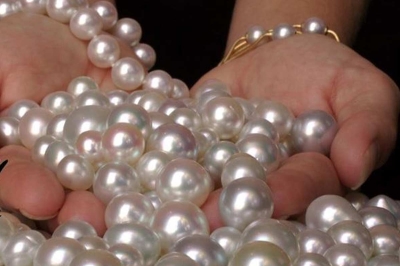Pearls are produced in various types, shapes and sizes and are divided into 4 categories based on the place of growth (with salt or fresh water) and the type of shell in which they are placed, each of which has a special beauty and charm

Pearl farmers employ various techniques to culture pearls, resulting in different types. Different methods of nucleation, implantation, and farming conditions can influence the shape, size, and quality of the resulting pearls. For instance, freshwater pearls are cultivated in freshwater environments, while saltwater pearls are produced in marine environments. Different species of mollusks produce pearls with distinct characteristics. For example, Akoya pearls are primarily produced by the Pinctada fucata oyster, while South Sea pearls come from the Pinctada maxima oyster. Each species has its unique traits, such as size, luster, and color, resulting in a variety of Pearl types.
Akoya pearls are known for their classic beauty and are primarily cultivated in Japan and China. They are typically small to medium in size, ranging from 2 to 10 millimeters. Akoya pearls have a high luster and are most commonly white or cream-colored, with overtones of rose, silver, or cream. South Sea pearls are cultured primarily in countries such as Australia, Indonesia, and the Philippines. They are among the largest pearls available, ranging from 10 to 20 millimeters in size. South Sea pearls are admired for their luxurious luster, often in shades of white, cream, or golden.
In general, we have two types of pearls: natural and cultured. The meaning of natural pearl is a pearl that is formed in the heart of nature and as a result of the accidental entry of stimulating factors into the oyster body. When a stimulus enters the body of a pearl-forming mollusk, the host organism secretes a substance to fight, which eventually leads to the formation of pearls. But in pearls grown in farms, the stimulus for the formation of pearls is manually entered into the shell, and the birth of pearls is no longer accidental.
Mabe pearls, also known as blister pearls, are cultivated by attaching a half-spherical nucleus to the inside of the mollusk's shell. As a result, they have a flat back and a domed front. Mabe pearls can be found in various shapes and colors and are commonly used in earrings, pendants, and rings. Conch pearls are rare and unique pearls found in the large marine mollusks known as queen conch. They are mainly sourced from the Caribbean Sea and are admired for their vibrant colors, including shades of pink, orange, and red. Conch pearls are highly sought after by collectors and Jewelry enthusiasts.
Natural and cultured pearls can be divided into two categories: saltwater and freshwater. Saltwater pearls take longer to form. Although salt water has a better shine and higher quality, it is slightly less durable and more expensive. But freshwater pearls are formed in a shorter period of time and are more abundant and more expensive, but they are not as bright as saltwater pearls and are usually smaller. Almost all types of pearls, both saltwater and freshwater, available in the market are cultured.
The structure of cultured pearls depends on the type of pearl that is placed inside the oyster as the primary nucleus. Another way to distinguish pearls from each other is that cultured pearls are yellow under ultraviolet light and green under X-ray light. Pearls are produced in various types, shapes and sizes and are divided into 4 categories based on the place of growth (with salt or fresh water) and the type of shell in which they are placed, each of which has a special beauty and charm. have their own Next, we describe the characteristics of each type.
Tahitian pearls, also known as black pearls, are cultivated in French Polynesia, particularly around the islands of Tahiti. They are renowned for their dark hues, which range from black to gray, peacock green, blue, and other exotic colors. Tahitian pearls are highly sought after for their unique beauty and large sizes. Freshwater pearls are cultivated in freshwater environments, such as lakes and rivers, primarily in China. They are typically irregular in shape and vary in size from small to medium. Freshwater pearls are available in a wide range of colors, including white, pink, lavender, and various pastel shades. They are often more affordable than other types of pearls.
The environment in which the mollusks live or are cultured impacts the growth and appearance of pearls. Factors such as water quality, temperature, salinity, and nutrient availability can affect the formation process, resulting in characteristic differences among pearl types. For example, Tahitian pearls develop their distinctive dark colors due to the unique conditions in the waters around Tahiti. Genetic factors can also contribute to variations in pearls. Just as individual humans have unique traits, mollusks within the same species can exhibit genetic variation, resulting in differences in pearl characteristics.





